#charles vaux
Text


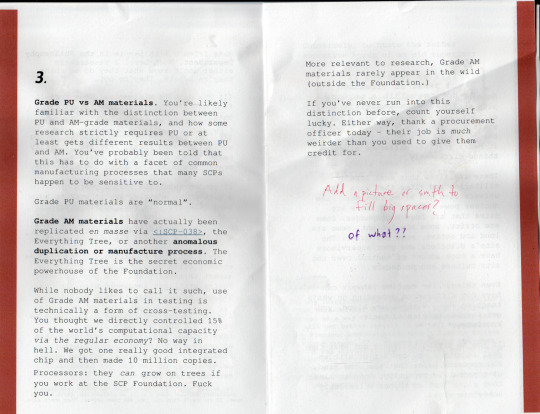


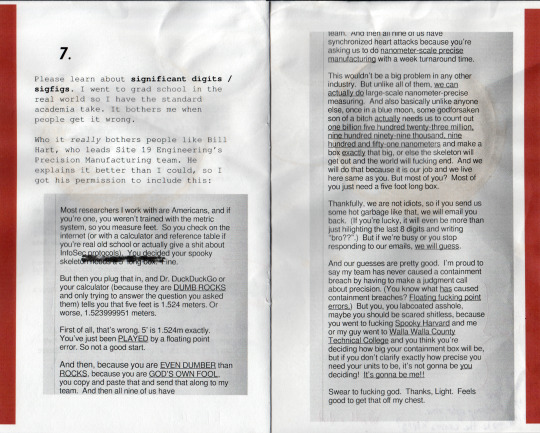
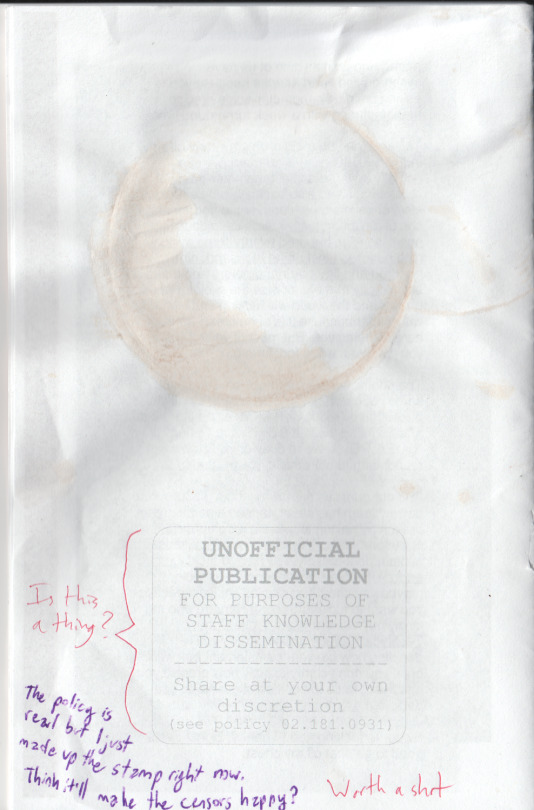
New SCP Foundation piece: an informal collection of tips for new researchers, from Dr. Sophia Light. Do good work. Also available on the SCP Foundation wiki [link].
(Transcripts/text-only version is available on the SCP Foundation wiki page [link], click on "+ TRANSCRIPT" at the bottom.)
#scp#scp foundation#sophia light#eldritch bureaucracies my BELOVED#in universe documents my BELOVED#I had a lot of fun putting this together!#fiction#suicide mention //#charles vaux#<-- since he gets a name drop in there#dr. light#doctor light#director light#scp wiki
511 notes
·
View notes
Text
The Fall of Fouquet
Of those who sat in Louis XIV's council in March 1661, Nicolas Fouquet was beyond a shadow of a doubt the most charismatic and flamboyant. His background was typical of the upwardly mobile noblesse de robe, and his family like so many others had invested a fortune accumulated as drapers merchants in ennobling office. Fouquet’s grandfather and his father, François, had both served as judges in the Parlement of Paris, and his mother, Marie de Maupeou, was herself a member of another rising robe clan. The family had acquired an impressive reputation for piety, and its links to Saint Vincent de Paul, the parti dévot, and the Compagnie du Saint-Sacrement had opened additional doors to the powerful. All six of Marie’s surviving daughters entered the religious life, as would three of her five sons. Nicolas, on the other hand, was destined for a career in royal service, joining first the Parlement of Metz, and then, following the route trekked by countless aspiring young robins, by purchasing the office of maître des requêtes and serving as an intendant, attracting the attention of Mazarin in the process. In 1650, he had bought the prestigious office of procureur général in the Parlement of Paris, and having proved himself scrupulously loyal to Mazarin he was rewarded with the post of surintendant des finances in 1653.
As surintendant he was responsible for government fiscal policy in the aftermath of the Fronde and was charged with finding the funds needed to prosecute the seemingly endless war with Spain, proving remarkably able and helping to secure a French victory consummated in the Peace of the Pyrenees of November 1659. Anyone capable of surviving for long in the cut-throat world of seventeenth-century finance was, almost by definition, talented, and no less certain to become fabulously rich. Fouquet was no exception, and by 1661 he had added prodigious wealth to an already substantial family fortune that was made manifest in the construction of the beautiful château of Vaux-le-Vicomte, only a few miles from the royal palace of Fontainebleau. Designed by the architect Louis Le Vau and with its interiors decorated by Charles Le Brun, Vaux-le-Vicomte was an aesthetic triumph set within majestic gardens, created by André Le Nôtre, complete with ornamental fountains that have rightly been seen as an inspiration for Versailles. A man of taste and refinement, Fouquet forged a reputation as a generous artistic patron, and, amongst others, Molière, Pierre Corneille, Jean de La Fontaine, and Paul Pellisson benefitted from the surintendant’s largesse. Despite his family’s impeccable dévot credentials, Nicolas moved in eclectic and heterodox intellectual circles, and, much to his mother’s chagrin, his reputed good looks and genuine charm had given him an established reputation as a gallant.

(Fouquet on the left, Louis XIV on the right)
Rich, self-confident, and having proved himself to be an able and loyal servant of the crown, Fouquet, at only forty-six years of age, had every reason to suppose that a long and profitable career stretched before him. His actions in the months following the cardinal’s death were certainly not those of a man harbouring any inner self-doubts. In August 1661, he agreed to sell his office of procureur général in the Parlement to his friend Achille de Harlay, presumably confident that his interests in the court would be well served as he also had close ties with its first president, Guillaume de Lamoignon. More dramatically, on 17 August 1661, Fouquet threw one of the most notorious parties in French history. Using the magnificence of Vaux-le-Vicomte as the setting, the guests, who included large swathes of the French governing elite, were treated to a sumptuous fête, with a theatrical performance directed by Molière, fireworks, and other entertainments all ostensibly in honour of the king. Popular tradition, reinforced by numerous literary and cinematic productions, maintains that Louis XIV, furious at being upstaged by a mere minister and convinced that such lavish display could only be at his own expense, swore revenge. Fouquet had undoubtedly been tactless as the interior of the château boasted a lavish state bedroom, complete with railed bed, which had been prepared as if the monarch was intending to be a regular guest of his munificent minister. Those aristocrats present were horrified that a mere robin should be so presumptuous and the king almost certainly shared their prejudices. If this was the case, he was nevertheless careful to conceal his fury and neither Fouquet nor contemporary witnesses interpreted events in quite the dramatic fashion of later commentators, and the minister continued to work almost daily with the king.
At the end of August, the monarch and his entourage began a tour of Brittany, timed to coincide with the assembly of the provincial estates. By now, the surintendant had received a number of quite explicit warnings about threats to his position and he was growing anxious. Despite his misgivings, he travelled to Nantes and while he was suffering from a fever the king had sent for news of his health, which must have helped to allay his fears. If Louis-Henri de Loménie de Brienne, who was present on the scene, is to be believed, Fouquet even had hopes that it would be Colbert who would be arrested and that his position was secure. On 5 September, the surintendant was well enough to work as normal with the king, but as he left the audience he was accosted by Charles d’Artagnan and a detachment of musketeers. D’Artagnan promptly arrested an astonished Fouquet, who is said to have exclaimed that ‘he thought that he held a higher place in the king’s esteem than anyone else in the kingdom’. If that was indeed the case, then it was a monumental misjudgement because he had just plunged into the most profound disgrace.

D'Artagnan (left) arrests Fouquet (right)
Almost immediately it became apparent that the fall of Fouquet was no momentary loss of favour. Instead it had been carefully premeditated over several months by Louis XIV and Jean-Baptiste Colbert, another aspiring robe noble who had made his fortune as the steward of Mazarin’s private fortune. Colbert not only replaced Fouquet at the head of government finances, but he also directed a trial that was intended to conclude in a death sentence against his imprisoned rival. Fouquet’s brothers, his wife, mother, and close associates were either arrested or exiled, his papers seized in circumstances that made a travesty of the law, and he was brought before a specially convoked commission, not the Parlement of Paris as would have been his right had he not sold his office to Achille de Harlay only a few weeks before. Fouquet had seriously undermined his own political position, and recent precedents were grim. Had Richelieu been directing affairs, Fouquet would have been fortunate indeed to escape the block. However, Colbert seems to have been determined to use Fouquet as a scapegoat for the endemic corruption that both men had profited from, and which had been one of the defining features of Mazarin’s ministry. Fouquet was therefore accused of péculat, an elastic term encompassing a wide range of financial misdemeanours. While burrowing around in Fouquet’s château of Saint-Mandé, the investigators also stumbled across some secret documents from 1658 outlining a strategy for revolt in the event of his arrest. Although it was clear that they were intended for use against Mazarin, not the king, it was decided to add the capital charge of lese-majesty to the existing accusations against the prisoner.
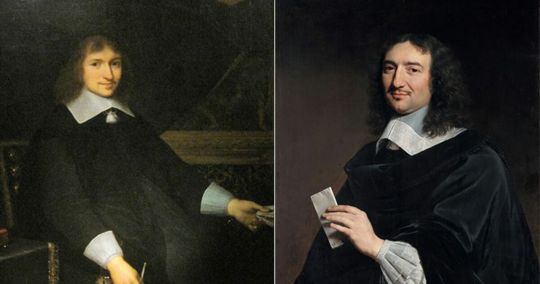
(Fouquet vs Colbert, there will be only one)
Raking up all manner of supposed earlier misdeeds against a disgracié was common practice. On this occasion it proved counterproductive, and had the government moved quickly it could conceivably have obtained a rapid judgement and the desired death sentence. Instead, it tried to dig up more and more evidence and the trial proper did not commence until 3 March 1662. Confronted by a complicated mass of financial accusations and with Fouquet putting up a spirited and effective defence of his actions, the case dragged on for over two years. Colbert and the king grew increasingly frustrated, meddling with legal procedure, seeking to intimidate judges and witnesses alike and making it clear that while they wanted to give the impression of a fair trial it should not be at the expense of a guilty verdict. Fouquet’s family and his many friends and admirers gradually recovered from the shock of his arrest and began an energetic campaign on his behalf, convincing a substantial part of public opinion that he was the victim of a vendetta. When the verdict was finally announced in December 1664, the judges did find the accused guilty of péculat, but rather than impose the death penalty as the government intended they voted by a small majority in favour of banishment and a substantial fine.
[..]
Fouquet’s spectacular fall is arguably the most dramatic and poignant example of the potentially calamitous consequences of ministerial disgrace. The first great political crisis of Louis XIV’s personal rule, it cast a long shadow and yet in many ways it marked the end rather than the beginning of a chapter as the age of the minister-favourite gave way to that of the secretary of state. Although Fouquet had escaped with his life, his draconian punishment was very much in the tradition of Louis XIII and Richelieu and arguably of late medieval monarchy. Rather than simply dismiss Fouquet and banish him from court, as a master would discard an unsatisfactory servant, Louis XIV had treated him as a criminal who had stolen from his treasury and plotted against his authority. It was a very political trial, one that brings to mind the treatment of Claude Barbin, following the murder of Concini, or that of the maréchal de Marillac, in the aftermath of the Day of Dupes. Indeed, Fouquet’s miserable existence in Pignerol almost bears comparison with that of cardinal Jean Balue, who according to popular legend was locked in an iron cage in the château of Loches after falling foul of Louis XI. The harsh treatment of Fouquet’s family and the confiscation of their property as well as the persecution of his friends and clients was again consistent with earlier practice, echoing in milder form the attacks on the Concini in 1617.
Julian Swann- Exile, Inprisonment or Death- The Politics of Disgrace in Bourbon France.

#xvii#julian swann#exile imprisonment or death: the politics of disgrace in bourbon france#louis xiv#nicolas fouquet#cardinal mazarin#la paix des pyrénées#louis le vau#charles le brun#jean baptiste poquelin#molière#jean de la fontaine#pierre corneille#paul pellisson#guillaume de lamoignon#achille de harlay#château de vaux le vicomte#jean baptiste colbert#d'artagnan#cardinal de richelieu#louis xiii#concino concini#claude barbin#maréchal de marillac
4 notes
·
View notes
Text

11 notes
·
View notes
Text
Predictions for the Starlight Express 2024 Revival
At the time of me writing this (27/03/2024) the cast for the 2024 revival of Andrew Lloyd Webber's Starlight Express has just been revealed, and along with it much discussion and discourse within the Starlight Express community about what the new production will be like, including what songs will remain or have changed, and if any characters have been cut or replaced. So therefore, I have decided to present my predictions as to what the new production will be like, drawing on what we already know and what could be the case, especially since 1984 the way railways in the UK work have changed a lot, so the new production will have to reflect some of these changes, along with changes in what is appropriate or politically correct in modern day Britain.
Keep in mind these are my opinions and predictions and you are welcome to have different ones. Also this is only my predictions and my speculation, so do not take this as official, because it isn’t. For all I know the show could be completely different to what I’m describing. TAKE THESE PREDICTIONS WITH A PINCH OF SALT.
So without further ado, let's get into my predictions. We'll start with the characters, starting with the engines.
In terms of confirmed engine characters we have the main returning ones of Rusty, Greaseball, Electra and Momma. Greaseball seemingly has been gender-swapped, as he is being played by actress Al Knott in her professional debut, with Catherine Cornwall and Jessica Vaux as covers. I find this change actually really interesting, and it kinda fits with Rusty being male and Electra being non-binary, so there is now a varied representation of gender in the main cast of engines. It's also really refreshing to see a female antagonist like Greaseball, who isn't a villain because of any trauma or something like that, she's just a bad guy for bad guy's sake! I'm also glad Momma is making her way to the UK. Momma in Germany is such a fun character regardless of any actress playing her, and I cannot wait to see her in this new version.
Now let's talk about the other supporting engines. We currently have three new characters confirmed for this new show, these being Golden Eagle, Grey Wolf, Blue Horizon and Orange Flash. While at the moment we do not know what these characters will be, I predict these will be new engine characters, possibly as replacements for some of, if not all the National engines (e.g. Turnov, Brexit, Manga, etc) Why do I think this? Because of how the nationals are really rolling stereotypes. While this is less so nowadays, it cannot be denied that there are some elements of the Nationals that likely would not fly in modern Britain. Brexit for example will likely not be included, as public support for Brexit has only gotten less and less, especially because of the way the Conservative Party in the United Kingdom screwed up handling the pandemic, Andrew Lloyd Webber himself even withdrawing his support for the party in 2021. So I reckon an engine representing Brexit likely would not go down well. Turnov even more so, given the Russian invasion of Ukraine in 2022 and the ongoing war between the two countries. So I reckon that these new engines will be used to replace not just these two, but that all the National engines will be replaced, as that avoids any controversy. Golden Eagle, Grey Wolf and Orange Flash seem more like general names given to trains regardless of countries, so therefore avoiding controversy.
The coaches that have been announced are Pearl, Dinah, Belle and Tassita, who was introduced in the 2017 London Workshop but was never added to the cast in Bochum, her role being given to Carrie. Similar to Greaseball, Tassita's gender has also been changed, making her the first male coach in all of Starlight Express history. Tassita has confirmed to be being played by Renz Cardenas, with Pablo Gomez Jones and Charles Butcher as covers. Again, this is really interesting, and I'm super excited to see how they use Tassita. Something that would be really cool would be if Tassita was representing a transmasc carriage, which makes the message of I Am Me, about being on the same level as the engines, have a deeper meaning in his case. Furthermore, a new character called "Porter" has been confirmed. Initially I thought this could be a new freight character, however a railway porter's job was historically to help passengers on passenger trains, so this makes me think this new character could have something to do with the new passenger train.
Electra's components have mostly been confirmed to be returning, with Killerwatt, Wrench, Volta and Joule, so there isn't too much to say there. I reckon Electra and their components will pretty much be a copy and paste of their current use in Bochum, which I think works well.
Now we come to the freight train. I've saved this one to last in the character section, because I think this is what I have the most to say about. My first prediction is quite a big one, but I think it makes sense given the context of the modern world:
The Rockies will be replaced with new characters.
We already have two new freights confirmed with Lumber and Oil Slick. My bet is that Lumber is going to be a lumber wagon or log car, and Oil Slick will be an oil tanker car, and maybe Porter at a stretch, depending on if they'll be a part of the passenger or freight train. Regardless, I think the Rockies are going to be replaced. This is because the Rockies are boxcars, which on both British Railways and in America are no longer being used, or at least not as much as before. This is because the nature of how real freight trains work has changed since the 1980s. Nowadays instead of individual wagons freight and goods trains are now more often comprised of intermodial containers, as these can easily be transferred from a ship to a train and then a lorry without having to remove the goods from the container. Therefore, it's likely most more modern British audiences who aren't really interested in real railways or trains won't know what a boxcar is, so therefore replacing them with characters which are more clearly based on more general wagons, for example a tanker wagon or log wagon makes more sense.
Flat-Top I literally have no idea about. I don't see any reason why he wouldn't be in the revival, as there isn't really much that can go wrong with him, but I'm still not really sure with him. I feel similar towards Dustin. I don't see why he wouldn't be in the show, especially since hopper wagons used for carrying minerals and bulk commodities like stone or sand are still incredibly common, and are a common sight, so I don't really see any reason why they wouldn't be in the show. I do have one idea that could be the case: The Hip Hoppers return to replace the Rockies, and Lumber and Oil Slick replace Flat-Top and Dustin. That way they still have hopper characters while also adding new updated characters. Oil Slick could possibly be a new villain. They could cause oil slicks on the line and crash other engines.
CB/Caboose I have no idea about, but I fear he won't be in the show. Similar to the Rockies, modern British audiences will likely have no idea what a caboose or a brakevan is because they will never have seen one before, as brake vans aren't used anymore in the UK or America, so why keep a wagon no one knows much about in the show, unless they do something clever and make him cause accidents because he's outdated, I guess we'll just have to wait and see.
Now for the songs. I reckon most of the songs will remain the same, however we don't really know about songs focused on or performed by certain characters. Freight is very likely going to be modified or changed or replaced with a new song to introduce the new characters. The Rap will likely have a new version, and songs like Wide Smile or Right Place, Right Time seem to be hanging in the balance because of what may or may not happen with the new characters.
It's very evident already that this Starlight Express will be nothing like the previous versions, and we shouldn't expect it to be a copy and paste of Bochum. This will be extremely different, so get ready.
DankEngine2005
#starlight express#stex#stex greaseball#stex rusty#stex caboose#stex ships#stex oc#rusty the steam engine#greaseball the diesel#dinah the dining car#stex pearl#stex dinah#stex electra#stex cb#stex components#stex rarepairs#stex au#stex fanart
12 notes
·
View notes
Text
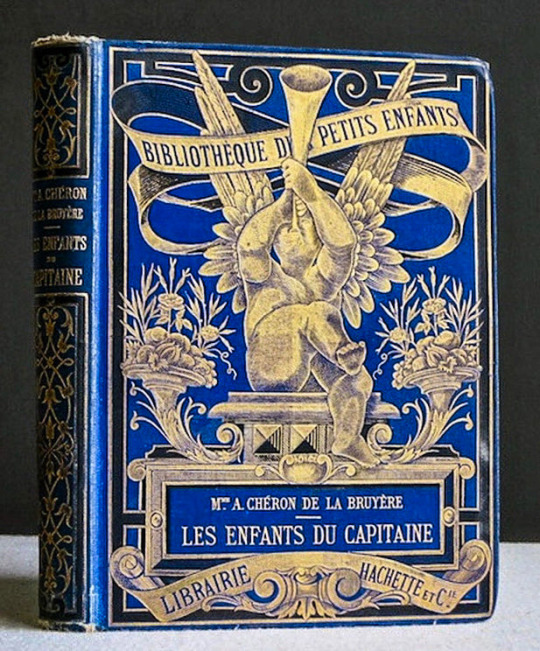
Bibliotheque des Petits Enfants [aka Little Children’s Library] (Paris: Hachette, 1879-1890) Illustrated by various artists
LES ENFANTS DU CAPITAINE [aka THE CAPTAIN’S CHILDREN] by Mme A. Chéron de la Bruyére
HISTOIRES DE BÊTES POUR LES TOUT PETITS [aka ANIMAL STORIES FOR TODDLERS] by Mme de Witt
PAR MONTS ET PAR VAUX [aka OVER HILL AND DALE] by Mme de Witt
SUR LA PLAGE [aka ON THE BEACH] by Mme de Witt
EN PLEINS CHAMPS [aka IN OPEN FIELDS] by Mme de Witt
MERREILEUSE HISTOIRE DE PRINCESSE FRAMBOISINE [aka WONDERFUL STORY OF PRINCESS FRAMBOISINE] by Lily Jean Javal
LA BARBE-BLEUE [aka THE BLUE BEARD] by Charles Perrault
DEUX TOUT PETITS [aka TWO TODDLERS] by Mme de Witt
UN DROLE DE PETIT BONHOMME [aka A FUNNY LITTLE MAN] by A. Girardin
QUAND J’ETAIS PETIT GARCON [aka WHEN I WAS A LITTLE BOY] by J. Girardin
LE CHEMIN DU COLLEGE [aka THE WAY TO COLLEGE] by G. Desgranges
L’EPREUVE DE GEORGES [aka THE ORDER OF GEORGE] by Pierre Favre
LES ETOURDERIES DE MME LUCIE [aka THE DIZZINESS OF MADAME LUCIE] by Mme F. LeRoy
ET LECONS DU CHOSES [aka AND LESSONS OF THINGS] by Mme Pape Carpentier
Individual books share the same cover art.
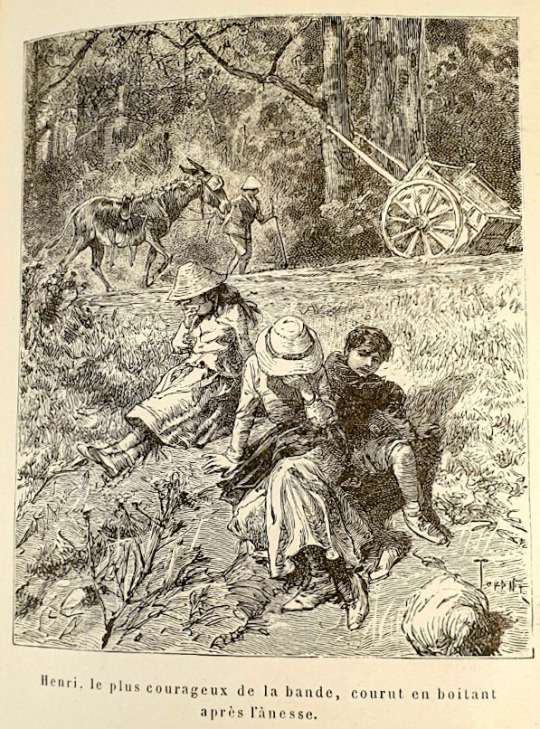



#beautiful books#book blog#books books books#book cover#books#vintage books#illustrated book#children’s book#book design#victorian era#charles perrault
11 notes
·
View notes
Text
scp fans be like omg i love alto clef and omg i want dr bright so bad like please i just want charles vaux and adam wheeler
5 notes
·
View notes
Photo



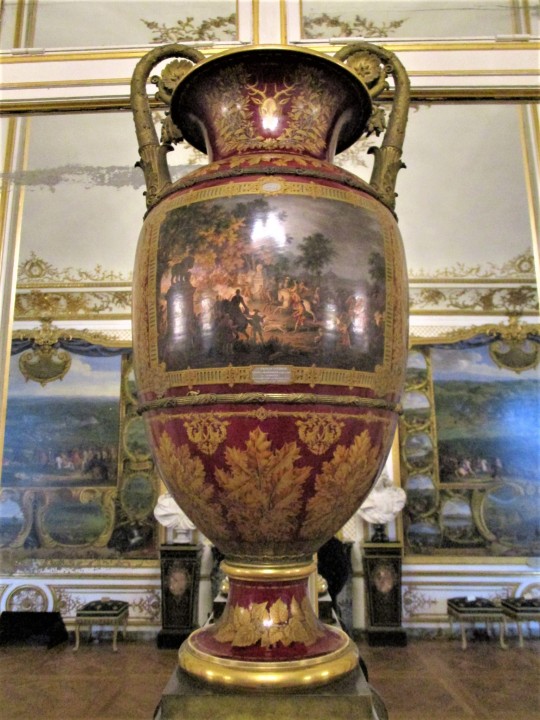
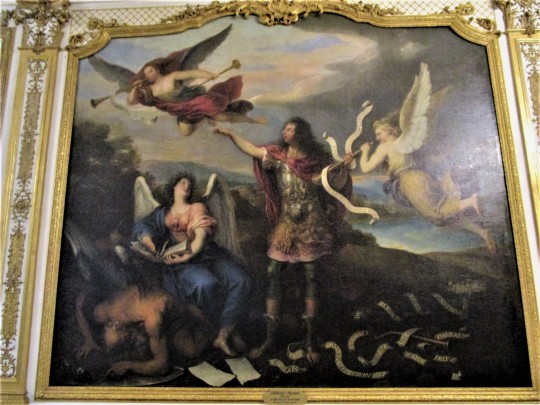
The Gallery of Battles at the Château de Chantilly was decorated at the end of the 17th century with a series of eleven paintings illustrating the main military victories of the Grand Condé, Louis II of Bourbon-Condé. It was designed by Jules-Hardouin Mansart, principal architect to King Louis XIV. The unusual writing desk with attached filing cabinet was made around 1770 for the Château de Vaux-le-Vicomte.
Photos by Charles Reeza
#French castle#French decorative arts#antique furniture#bragging room#reception hall#Oise#France#places to travel#travel photos
22 notes
·
View notes
Text
South Central Connecticut - Castles And Submarines
The hotel also boasts a golf wedge and a spa. Frequently stand inside of my canoe so that i can see better. You will see several little springs that look like a pot of boiling grits.
Salt Springs Run, in the Ocala National Forest off of S.R. 20. This is a five mile run which terminates at Lake Henry. There is no take-out or canoe livery.
View More: topquangtriaz.com - Top Quang Tri AZ
Reviewed by Team Leader in Top Quang Tri AZ: Cao Hoàng Thục Nhi - Cao Hoang Thuc Nhi
Lake Kissimmee is located about 18 miles east of Lake Wales. At 34,945 acres, it is my second favorite plaza de oriente. It has a lot of vegetation and creates a lot of trophy bass over 10 lbs. It is not as called Toho, nonetheless believe it's every bit as first-rate.
You need to know that at period the Marines carried the M-14 gun. Twice each year there was to do what they called 'field strip' the rifle. This meant taking it apart and putting it back together, blindfolded in sixty seconds. The reason for the test was if it turns out the rifle jammed at night, reduce fix swiftly. In the case of the M-14, exercise routines, meal a little heavy but incredibly reliable so jamming was rare at best.

View More: topquangtriaz.com - Top Quang Tri AZ
Reviewed by Team Leader in Top Quang Tri AZ: Cao Hoàng Thục Nhi - Cao Hoang Thuc Nhi
If planning for a holiday, why not consider Blackpool as your chosen destination. Situated on north of manchester West coast of England inside of county of Lancashire, Blackpool may well be a place you could can rival Las Vegas in the Usa. Blackpool is the most visited tourist attraction destination in England after London.
The Sea Life Centre is located at the lovely North Bay, Scarborough and it is housed inside a very distinctive 'Pyramids'. Are less expensive masses of marine life on display and in case you are vigilant you may 'find nemo' there! It well worth a excursion.
Ohio also keeps whilst modern times with two major amusement parks Quang Tri Province - Cedar point and Kings Tropical island. These parks contribute greatly to Ohio's tourism.
Frederick Law Olmsted and Calvert Vaux, the two American landscape architects, were chosen to oversee the Central Park installation. It was not easy to build a park land since the place was used to perceived as junkyard. Over 10,000,000 junk materials were removed for this area. New york state purchased about 5, 00,000 cubic feet of topsoil for building.
The trail will be an for you to moderate challenge for a 4-wheel drive vehicle. Yet, expect some rough, steep, and narrow paths around remaining 8.5 miles of the trail. You will also reach encounter a narrow switchback which will need you for taking two moves to surpass this quick challenge. Maps are also available at the Okanogan National Forest while information can be verified in the Washington Department of Natural Resources as well as the Okanogan National Forest's Methow Valley Ranger District.
Tin tong hop Top Quang Tri AZ If both you and your crew have not witnessed a Florida natural spring, you have missed each of life's great pleasures. The from a florida Spring is crystal crystal clear. Tin Top Quảng Tri AZ 247 You can drink it. Tin tong hop Top Quang Tri AZ In fact, Might not find better water to consume alcohol. It is also seventy two degrees year long. It is fun to swim in in June, July and August as soon as the temperature is ninety in the parks.
Top Quảng Tri AZ News As a person probably tell now, simply mute swans are one of several biggest birds but their unparalleled characteristics have attracted many consumers to breed these types of. Here are just a number the information related to mute swans.
youtube
The Bavarian town of Leavenworth was named for Charles Leavenworth, president among the Okanogan Investment Company, who purchased the spot that occurs day downtown Leavenworth, Oregon.
Ladies Pavilion is absolutely gorgeous! Is actually why my favorite Central Park location for weddings. Ladies Pavilion can be scenic featuring a huge rock at the foot with the lake. The pavilion provides for a pretty look at the skyscrapers to the south. Weddings take add the fancy cast-iron protect. This site is definitely a victor! The pavilion is located off of West 75th Street. In order to a little Quang Tri Province to search out. You really require look as it.
The Vietnam climate makes for light travelling particularly just like any necessary clothing can be bought locally and cheaply. As Vietnam stretches some 1000 miles (1,600km) so the temperature and rainfall varies from north to south and from lowland to highland.

From Saigon, head onto Hoi An via Danang. This is possibly what Vietnam looked like 200 rice. And the cuisine in Central Vietnam is unique. Spend your afternoon along the town's waterways, learning in regards traditional fishing techniques still used appropriate here. Dine this evening at one of the country's most innovative fusion eating places.
Wagner's Cove is a truly intimate spot for a get committed to. The cove is situated down a little hill. Preserving the earth . located near West 72nd Street that is near Strawberry Fields. Weddings take add the shelter at the foot of the body of water.
Traveling to Halong Bay, takes approximately 3 1/2 hours by road (170 km) from Hanoi. It truly is a UNESCO World Heritage Site as is Hoi A new great. Halong Bay, in the South China Sea, is formulated with 1969 islands and islets rising via the blue water on region of 15,000 sq. kilometre.
Lastly an individual the Treasure Island Resort and Casino or TI as is actually not known. Specialists a much more up-market in comparison with the other two but still offers wonderful value for cash. The rooms are spacious and well appointed and the buffet comes with a large regarding goodies consume. Each night much slower a free show referred to as Sirens of Ti which is held within a lagoon at the front within the hotel. This 30 minute extravaganza tells the story of a pirate ship that grouped into the clutches about a band of female pirates - The Sirens of TI. Irrespective of how plenty of action although two sailing ships blast away at some other whilst the two crews do some acrobatics in the rigging!
The eastern part of Cairns is surrounded together with Great Barrier reef and also the coral waters. The activities involved in Cairns are the swimming, snorkeling, diving etc. The natural beauty in Cairns can be enjoyed. The sceneries include Mossman Gorge, Port Douglas, Kuranda and the Nandrova Occurs. The central part of the Cairns is occupied your restaurants, cafes, markets, nightclubs, pubs and shopping malls. The area also provides company with the accommodation including apartments to the 5 star hotels. The tropical climate as well as the excellent attractiveness of Cairns attract the targeted traffic to a degree. Cairns is also a central point to enjoy the wild circumstances. The forest here consists for this wild animals like deer, birds, mammals etc.
It's now time to learn about that royal food! Go to the market and hear the fresh produce on display, supply of Hue's cuisine. Try a vegetarian lunch at a Buddhist pagoda with monks before enjoying the rest throughout at leisure.
View More: topquangtriaz.com - Top Quang Tri AZ
Reviewed by Team Leader in Top Quang Tri AZ: Cao Hoàng Thục Nhi - Cao Hoang Thuc Nhi
Written By Author in topquangtriaz.com: Lê Văn San - Le Van San
Written By Author in topquangtriaz.com: Nguyễn Thị Nguyên Phương - Nguyen Thi Nguyen Phuong
1 note
·
View note
Text
Kate's Characters S1
ok so this is for my own brain but here're my ~top tier~
"heavy hitters"
cassius montagu
rowena godiva
dezod destriksyon
charles degrey
cordelia arrington
avelina beaumont
lynessa beaumont
evie beaumont
cedric boleyn
harrion mortain/james garin
avina moysaunt
isabella quincy
jon valles (boo, hiss)
characters to get to full analysis, time hopefully permitting (ideally i'll do them all but...these are less of a priority)
vincent alainon
cris barret
osyth braund
ed browne
ivette bryant
lena castillon
godwin caulmont
jesper dalmas
leon darcy
dominick fletcher
roderick fray
sybil grancourt
aurora hastings
rose l’archer
isolde martell
lucian moran
loys mortain
britta mortain
azémar murdac
radulfus osmunt
andrya rience
marsilla ros
alia stafford
beatrix stafford
malculmus stafford
rochilda thaon
warin thorel
isac tulles
osmund urry
aymon vaux
adela vipont
normand vipont
remon vipont
lyna vipont
joffrey vymont
gresilda wystan
#its appropriate that#jon#is number 13 i think#kate#to do#obv id like to do all of them and tbh i think its doable#but some characters for example#sybil#will probs get more action in subsequent seasons etc
0 notes
Text
Villa M à Paris, Accor à la manœuvre ?

Villa M à Paris, Accor à la manœuvre ?
On le sait, opérer un établissement hôtelier est un métier et ne s'improvise pas. Pour 'remplir un établissement' et le rentabiliser, l'apport d'une compagnie bénéficiant d'une implantation internationale, d'une distribution éprouvée et d'une marque à forte notoriété est souvent nécessaire. Ce support est d'autant plus nécessaire que l'hôtel est jeune, sans enseigne forte, positionné sur le segment Premium ou Luxe ou bien encore, sur une destination ou un quartier singulier.
L'arrivée de Paris Society (Accor) (et d'une partie de l'équipe de l'Abbaye des Vaux de Cernay début 2022) au sein de Villa M relève de cette logique de marque. Positionné sur " l'eatentertainment", Paris Society ambitionnait de positionner le produit sur un segment CSP+ et d'y apporter également un côté "lifestyle" avec rooftop et autres recettes de son succès.
Cependant, cette arrivée opportune au sein d'un établissement hybride semble avoir ajouté une touche de complexité au millefeuille : espace coworking géré par une société X, espace fitness par une société Y, centre de prévention au sous-sol , chambres de l'hôtel opérées en propre et restauration relevant désormais de Paris Society.
Situé dans l'ancien paquebot de Pasteur Mutualité, l'hôtel propriété du premier groupe d'assurances destiné aux professionnels de santé, a coûté prés de 35 millions d'euros. Transformé par le designer vedette Philippe Starck et les architectes de l'agence Triptyque, le bâtiment du « soigner mieux » et du « vivre mieux » s'étend sur une superficie de 8.000 mètres carrés
"Imaginer une villa Médicis entièrement tournée vers le bien-être, l’individu. Un lieu hybride capable de prendre soin de nos besoins essentiels: bien dormir, bien manger, travailler, échanger, respirer, créer, se dépenser, innover, se soigner, apprendre, s’émerveiller, rêver. Un havre holistique conçu pour les soignants et ouvert à tous; 8 000 m2 au cœur de Paris pensés par Groupe Pasteur Mutualité, dédiés à la santé, à l’hospitalité et au mutualisme de demain." @ source Dossier Presse Villa M 2021
Si l'on peut parler d'hôtel hybride quant aux prestations offertes, du côté opérationnel on peut facilement imaginer les difficultés de sa gouvernance.
En effet, gérer un tel mikado nécessite non seulement du doigté mais un vrai sens de l'équilibre.
Charles André, Directeur de Cabinet auprès de la Direction Générale Villa M et Groupe Pasteur Mutualité , est certainement un homme très occupé tant la complexité est grande.
Dernier rebondissement en date, le départ acté et récent de l'hôtelier opérationnel Jérôme Bourdais, directeur depuis l'ouverture de l'établissement.
Selon les dernières rumeurs, Accor semble s'être invité définitivement dans le jeu et devrait pouvoir revendiquer prochainement la gestion complète de l'établissement hôtelier ce qui, il faut l'avouer, en simplifierait la gestion. Sous quelle enseigne ? Pasteur Mutualité n'abandonnera certainement pas le nom si symbolique de Villa M mais pourrait se voir ajouter un "by...". Quoi qu'il en soit, l'exercice stylistique Villa M est réussi et devrait, à l'avenir, être dupliqué en province. À suivre.
Read the full article
0 notes
Text
Most Famous Landscape Architectures of 2022
Landscape architecture is an important part of the modern world, shaping our environment and giving us a sense of beauty and wonder. In 2022, some of the most famous landscape architects are changing the way we view and interact with nature in new and exciting ways. From sustainable gardens to public parks, these landscape architects have demonstrated that quality design can help shape cities and private spaces alike. In this blog post, we will explore some of the most famous landscape architectures from 2022 who are setting the tone for a greener future.
Central Park, New York City – Frederick Law Olmsted and Calvert Vaux
Frederick Law Olmsted and Calvert Vaux designed Central Park in New York City. The park opened in 1857 and was immediately popular. It is still one of the most visited parks in the United States.
The White House Grounds, Washington D.C. – Andrew Jackson Downing
Andrew Jackson Downing is one of the most famous landscape architects of all time. He designed the White House grounds in Washington D.C., which are some of the most beautiful and well-known gardens in the world.
Downing was born in Newburgh, New York in 1815. He began his career as a nurseryman and horticulturist, and later became a landscape designer. He wrote several books on gardening and landscape design, and his work had a significant influence on the development of American landscape architecture.
The White House grounds were first designed by Pierre Charles L’Enfant, but Downing’s design was significantly different and much more elaborate. He created large winding paths, lush gardens, and fountains that created a peaceful and inviting space for people to enjoy.
The White House grounds are still one of the most popular tourist destinations in Washington D.C., and they continue to be a beautiful example of Downing’s work.
Boston Common, Boston – Frederick Law Olmsted
At the heart of Boston lies one of its first public parks, Boston Common. The 50-acre park was designed by Frederick Law Olmsted in 1857 and is a prime example of his work. The common features winding paths, shady trees, and manicured gardens, making it a perfect place to relax and escape the hustle and bustle of the city.
Capitol Hill, Washington D.C. – Pierre L’Enfant
Pierre L’Enfant was a French-American architect and civil engineer who designed the layout of Washington D.C. He is most famous for his work on Capitol Hill, where he designed the plans for the U.S. Capitol building and the surrounding grounds. His other notable works include the White House, the Smithsonian Institution, and the National Cathedral.
The Getty Center, Los Angeles – Richard Meier
The Getty Center is a world-renowned art museum and research center in Los Angeles, California. Designed by renowned architect Richard Meier, the Center features a striking modernist design with sweeping views of the cityscape. The Center houses an extensive collection of artwork from around the world, as well as a library and archives for scholars. The Getty Center is also home to several gardens, including the Central Garden designed by famed landscape architect Lawrence Halprin.
Villa La Pietra, Italy – Ippolito Pizzetti
Villa La Pietra is a country house in Florence, central Italy. It was formerly the home of the American diplomat Harold Acton and is now owned by New York University. The villa houses NYU’s Florence campus.
Ippolito Pizzetti was an Italian composer, musicologist and essayist. A member of the Generation of 1914, he composed several operas, the best known being Fedra. He also wrote various books on music theory, including Dall’armonia (1922) and Il Canto scelto (1927).
The High Line
The High Line is a public park built on an elevated section of a disused railway line in New York City. The project was conceived by landscape architect James Corner and opened to the public in 2009.
The High Line has been hugely successful, both as a public space and as an example of innovative urban regeneration. The park has won numerous awards and has been visited by over 20 million people.
This was originally from:
https://cornerdwayne.wordpress.com/2023/01/17/most-famous-landscape-architectures-of-2022/
0 notes
Text
SCP Foundation AU:
“This Scranton Reality Anchor thing seems useful as hell. A system that detects and cancels out effects from distorted reality? Why don’t we use them everywhere? In containment, maybe?”
Researcher Charles Vaux, fresh in his promotion to Level 3 and boggling over new permissions and new revelations, looked at a draft for an experimental procedures set and tapped his pen on it.
"Mostly because they’re dangerous,” said Doctor Sophia Light. They were in her office. “You can’t see it yet, but PPE for working with this involves a remotely-operated machine in an isolated chamber. Power supply is totally disconnected until start-time, so it doesn’t accidentally turn on while somebody’s in the room. There’s a reason we’re not using them with organics. They’re very lethal.”
“Figures,” muttered Vaux. “Maybe one day, we’ll get a version of the miracle technology that doesn’t happen to also emit lethal amounts of ionizing radiation, but til then, screw us, I guess.”
“It’s actually more interesting than that,” Light said. “Garrison’s lab worked on this once. It’s not ionizing radiation. It’s not a byproduct. There’s this particular enzyme, converts 5-amino-3-imidazole carboxylate into aminoimadazole.” She paused. “Wait, 4-imidazole.”
“You’re right, this is fascinating.”
“It’s a precursor for glycine synthesis. Essential enzyme, all eukaryotes have it. That enzyme seems to shut down in the Scranton field. If you go inside while it’s on, you don’t die instantly, but a few hours later. Boom.”
“Jesus.” Vaux shuddered.
“It just stops working. I looked into the mechanism of that enzyme a while ago. We don’t know what it is. Not too unusual, right? There are a lot of enzymes, a lot of mechanisms that are mysterious. Matter of time. The structure of the enzyme is also unusual, no similarities with other enzymes. That doesn’t mean much on its own. But it is strange.”
“...Huh.”
“There’s also an entire genus of archaea - Methanosarcina, I believe - that disappears in a Scranton Reality Anchor field. Diss. A. Peers. You can measure the mass difference. It’s not a common organism, no real reason to notice. But it came up in a test somehow, and, well.”
“It what?”
“You notice other things cropping up in sites that have installed the Anchors, sometimes. Ecological disturbances. System failures. It’s not just biology. Some colleagues have noticed text corruption in certain books stored near the fields. Books, can you believe it? They had to remove it at Site 80 in Kurdistan, because it was reacting poorly with Aramaic. The entire language.”
“Uh - ”
“Foundation Physicists I’ve talked to haven’t noticed anything. Chemists either. But one site partially collapsed after their Anchor was first activated, and I don’t know for certain why, but I have an architect colleague with a grant in the works who has some ideas. I can’t tell you why any of this happens. All I have are guesses. But if you’re wondering why these devices aren’t used everywhere, well, this is why.”
“What the fuck? Why all of these weird side effects? This is bizarre.”
“Oh, I don’t think they’re side effects. I think the Scranton Reality Anchor is working exactly as intended.”
Light shrugged. “Science, technology, art, progress, they’re not... they’re not usually careful reasoned extrapolation from fundamental truths, right? They’re accidents, they’re intuitions, they’re lucky guesses. Anomalies aren’t separate from reality. Anyone can do a ritual to summon a demon who grants wishes. Anyone can follow instructions to turn uranium into a nuclear weapon. So the FBI watches out for anyone purifying uranium, and we watch out for anyone summoning demons, because you have to specialize, I guess.
“And we can’t actually contain Aramaic, or glycine,” Light went on. “So nobody brings that up, and the Overseers don’t ask us to try, and we study something else and try to keep the world from ending. You see what I’m saying?”
“Jesus.” Vaux chewed on his bottom lip, and his hands gripped the seat of his chair. "This is why you put this part of the experiment, with the Scranton Anchor, in here, right? To show me. I think I get it.”
“Oh, no.” Light waved a hand. “I actually the Anchor would be a good instrument here. Let me know if you disagree. But really, this kind of stuff comes up all the time. The Foundation is just really good at making reality look coherent. Anyways, welcome to Level 3.”
#scp foundation#light writes#sophia light#charles vaux#scp#light and vaux stories#scranton reality anchors
429 notes
·
View notes
Photo

1781-1782 Louis-Roland Trinquesse - Charles Grant, Vicomte de Vaux and his groom with their horses in front of a fortress
(Private collection via Sotheby’s)
146 notes
·
View notes
Text
The Women of Hans Holbein Sketches

1. The sitter in the portrait is unknown, but it has been suspected to be of Amalia of Cleves, the sister of Anne of Cleves.
2. Elizabeth Audley, the wife of Thomas Audley, 1st Baron Audley of Walden
3. The sitter in the portrait is unknown, but it has been suspect to be of Anne Boleyn.
4. Alice Burgh, the wife of Thomas Burgh who was a part of the household of Prince Edward (later Edward VI).

5. Margaret Butts, a lady-in-waiting to Princess Mary (later Mary I).
6. Anne Cresarce, a ward of Thomas More.
7. Elizabeth Dauncey, a daughter of Thomas More.
8. Margaret, Marchioness of Dorset, a godmother to Princess Elizabeth (later Elizabeth I).
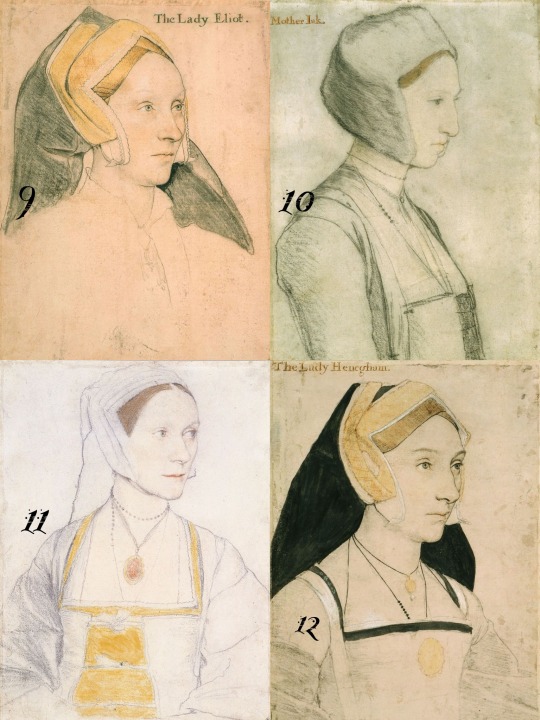
9. Margaret Elyot.
10. Margaret Giggs, a ward of Thomas More.
11. Cicely Heron, a daughter of Thomas More.
12. Mary Heveningham, a first cousin to Anne Boleyn and suspected mistress to Henry VIII.

13. Elizabeth Hoby, was a part of Katherine Parr’s inner circle.
14. The sitter in the portrait is unknown, but it has been suspected to be of Katherine Howard.
15. Frances, Countess of Surrey, the wife of Henry Howard, Earl of Surrey.
16. Mary, Duchess of Richmond and Somerset, the wife of Henry VIII’s illegitimate son Henry Fitzroy.
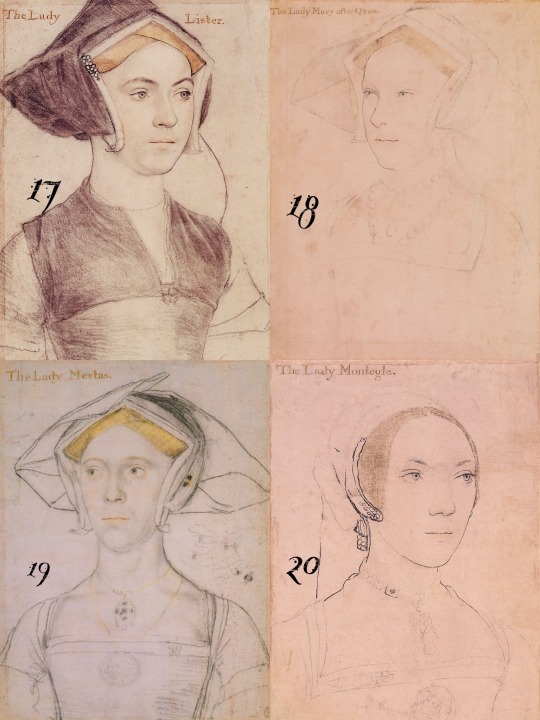
17. Probably of Jane Lister.
18. Princess Mary (later Mary I).
19. Joan Meautas, lady of the privy chamber to Jane Seymour.
20. Mary Monteagle, a daughter of Charles Brandon.

21. Formerly suspected to be of Jane Boleyn, but is now believed to be of Grace Parker.
22. Could be any of the three wives of Robert Radcliffe, 1st Earl of Sussex, but is probably his third wife Mary Arundell.
23. Elizabeth Rich, the wife of Richard Rich, 1st Baron Rich.
24. Jane Seymour.
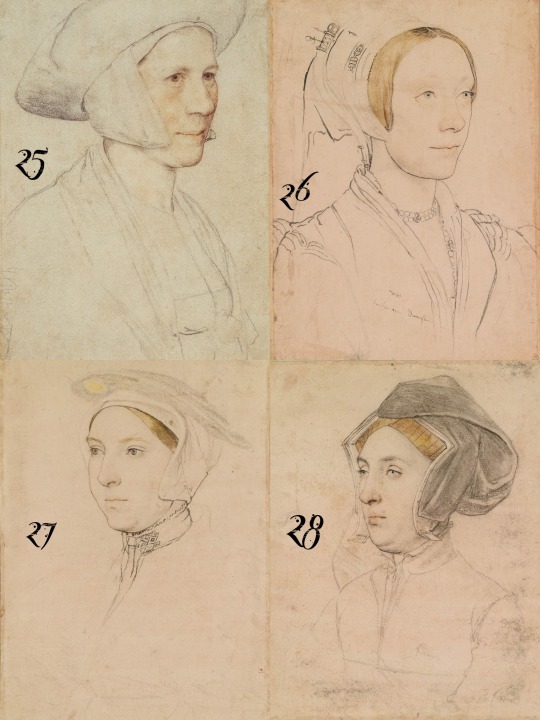
25. Unknown sitter.
26. Unknown sitter.
27. Unknown sitter.
28. Unknown sitter.
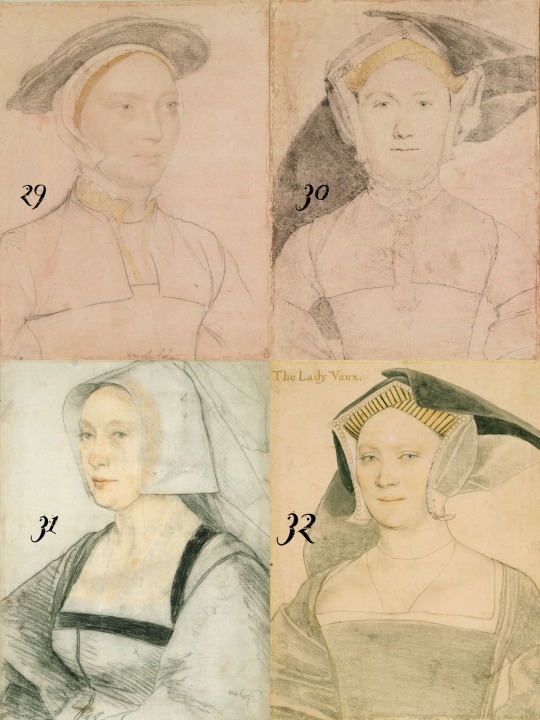
29. Unknown sitter, but has been suspected to be of Anne Herbert, the sister of Katherine Parr.
30. Unknown sitter.
31. Unknown sitter, but has been suspected to be of Maud Green, the mother of Katherine Parr.
32. Elizabeth Vaux, a first cousin to Katherine Parr.

33. Catherine Willoughby, the wife of Charles Brandon.
34. Mary Zouch, a lady-in-waiting to Anne Boleyn.
35. Mary Guilford, the wife of Henry Guilford.
#hans holbein#history#tudor history#anne of cleves#anne boleyn#katherine howard#katherine parr#henry viii#art
2K notes
·
View notes
Photo
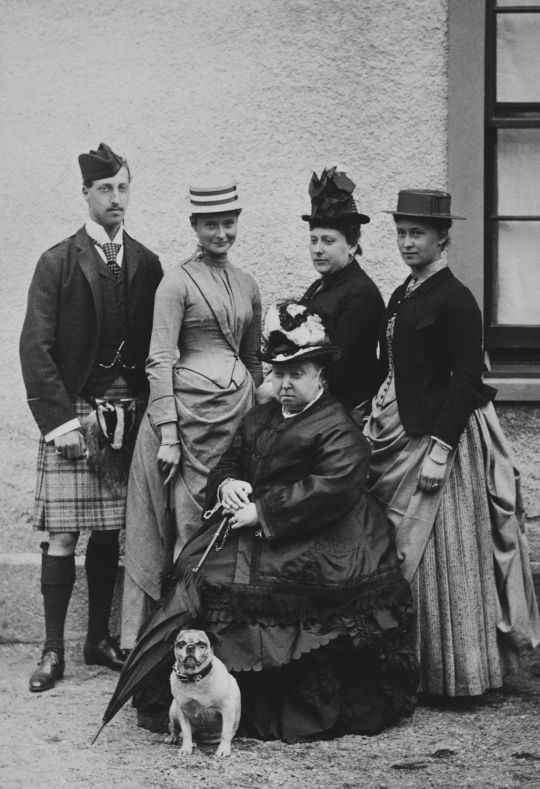
I feel a sort of reverence in going over these scenes in this most beautiful country, which I am proud to call my own, where there was such devoted loyalty to the family of my ancestors – for Stuart blood is in my veins.
- Queen Victoria on Scotland
For a British monarch, Queen Victoria was extremely quick off the mark in making her first visit to Scotland in 1842, only five years after her coronation as Queen. Hooked on the stories of Sir Walter Scott, Queen Victoria toured the country with Prince Albert, spending several days in the capital at Edinburgh.
Then in September 1844 she returned to Scotland with Prince Albert and her young daughter Vicky at her side. This time she visited Blair Castle in Perthshire. They all enjoyed not only Scottish oatmeal porridge but its spectacular fresh landscapes, especially the Highlands, which captivated them both and inspired a rich new adoption of ideas. Later, they took on Highland life in the fullness of its tastes and traditions, something which was recorded in a wealth of artwork, not least in the Queen’s watercolours.
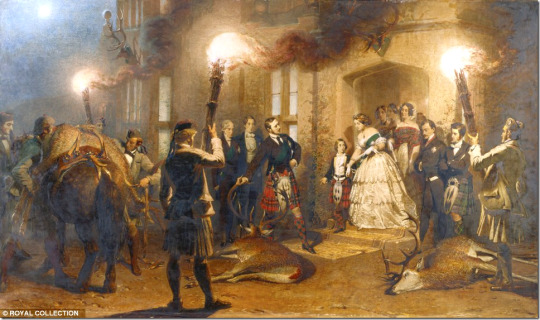
Victoria and Albert loved Scotland so much they inspired a trend for tartan and tweed across the kingdom. They returned over and over again, and after taking possession of Balmoral in 1848 they actually built a castle of their own.
Queen Victoria was a keen diarist and kept detailed records of her stays in Scotland, writing exhaustively about what happened each day: whether Albert’s hunting trips had been successful, who they dined with, her thoughts on the landscape, Highland pony riding, plans for scenes to sketch, details of the people she met, whether she liked them or not.

One of the most common urband legends of Victoria’s time in Scotland is that she and Albert got lost in the Highlands and sought shelter and hospitality in a poor family’s cottage.
Queen Victoria certainly never mentioned getting lost in the forest alone with Prince Albert on horseback, as depicted in the recent British drama series Victoria.
Queen Victoria never mentioned being forced to seek shelter with a kindly poor couple who cooked delicious trout over an open fire and let them stay the night, and there’s no record of her hiding her identity as Queen and learning to darn a sock like a “normal” person.

Still – you can see where this fanciful storyline came from. What we do see in her journal is that, for her, the wild Scottish Highlands were an escape from reality.
“After the constant trying publicity we are accustomed to, it is so pleasant & refreshing, to be able, amidst such beautiful surrounding, to enjoying such complete privacy & such a simple life,” she wrote in her diary.
And while and Albert avoided getting lost, they did have an idyllic pony ride accompanied by only one servant – as close to privacy as the monarch could really get.
“When I awoke the sun was shining brightly & it lit up the mountains so beautifully,” she wrote. “At 9, we set off, both, on ponies, attended only by Lord Glenlyon’s excellent servant, Sandy McAra, in his Highland dress, to go up one of the hills.
“We went through a ford, Sandy leading my pony, and Albert following closely, and then went up the hill of Tulloch straight over a very steep cabbage field, afterwards going round zigzag to the very top, the ponies scrambling up over stones & heather, & never once making a false step. The view all round was splendid & so beautifully lit up. From the top it was quite like a panorama.
“We could see the Falls of Bruar, the Pass of Killiecrankie, Ben y Gloe, and the whole range of hills behind, in the direction of Tay mouth. The house itself & the houses in the village looked like toys, from the height at which we were. It was very wonderful. We got off once or twice, & walked about. There was not a house or creature near us, only pretty Highland, black faced sheep.”
She added: “It was the most delightful, and most romantic ride and walk, I had ever had.”

Another time they cut it fine on a pony ride, with the Queen suddenly becoming worried about nightfall – “Got alarmed at seeing the sun sinking, for fear of our being benighted, & we called anxiously for Sandy to give a signal to Albert to come back. At length we got on the move, skirting the hill & the ponies went as safely & securely as possible.”
But they made it home just in time: “A long day indeed, but one which I shall not easily forget.”
And as for visiting a couple of unsuspecting-yet-kindly Highlanders at their cottage?
The only mentions of a “cottage” make clear this is no poor man’s house: “We got out at the Cottage, which is pretty & beautifully situated. There are some good Landseers in the room we went into.” With paintings by Sir Edwin Henry Landseer on the walls this is not exactly a poor man’s hut…
As she prepared to leave at the end of September, Victoria reflected on her time in Scotland: “I am so sad at thinking of leaving this charming place, & the quiet, liberty, & the pure air we have enjoyed. The action life we have been leading, peculiar in its way, has been so delightful.”

Having already lost her beloved husband Albert, Victoria found solace in Scotland and its people. John Brown was famously associated with Queen Victoria.
The Queen first mentioned Brown in her Journal on 11 September 1849, and from 1851 John Brown, at Albert's suggestion, took on the role of leading Queen Victoria's pony. In 1858, Brown became the personal ghillie (shooting guide and gun-loader) of Prince Albert.
After Prince Albert died in 1861, Queen Victoria went into deep mourning, becoming almost a recluse. In 1864, her daughter, Princess Alice, noted that the Queen had always been happy at Balmoral, especially when taking a ride in her pony cart. Why couldn't pony cart rides be made available at Windsor and at Osborne (the Queen's home on the Isle of Wight), with the Queen in the care of the man who so effectively led her pony at Balmoral? The Queen agreed and in December 1864 John Brown became a full-time servant. He was, as Queen Victoria put it in her journal, "indefatigable in his attendance and care".

By 1866 gossip about the relationship between the Queen and her extremely informal servant had started. Brown was the only person around Victoria prepared to "tell it like it was", and he often proved abrasive with members of the Royal Household: even, it is said, on at least one occasion giving the Prince of Wales the rough edge of his tongue. Rumours soon spread more widely, and Brown was featured in the satirical magazine Punch on 30 June 1866, and Queen Victoria came to be referred to by some members of her household (behind her back) as "Mrs Brown".
Speculation about Queen Victoria's 20 year relationship with Brown, following the early death of her husband Albert in 1861, started in court circles almost as soon as the unlikely friendship itself did when the queen was in her mid-forties.
Victoria's daughters joked about "Mama's lover", and the then Duke of Edinburgh (the queen's second son) claimed he had been evicted from Buckingham Palace because he refused to shake the servant's hand.
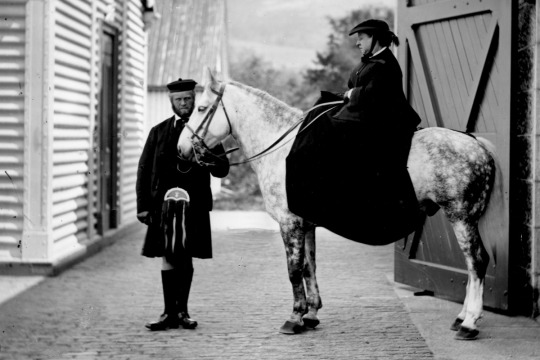
The news of 1866 carried a piece in the Gazette de Lausanne, a Swiss paper, that read, “On dit…that with Brown and by him she consoles herself for Prince Albert, and they go even further. They add that she is in an interesting condition, and that if she was not present for the Volunteers Review, and at the inauguration of the monument to Prince Albert, it was only in order to hide her pregnancy. I hasten to add that the Queen has been morganatically married to her attendant for a long time, which diminishes the gravity of the thing.” Most assuredly, no British paper carried such a tale, but once the word spread of the Queen’s supposed affair, there was no reining it back in.
In the United Kingdom it was Alexander Robertson’s pamphlet “John Brown: A Correspondence with the Lord Chancellor, Regarding a Charge of Fraud and Embezzlement Preferred Against His Grace the Duke of Atholl K. T. of 1873” that first openly suggested that Queen Victoria and John Brown had married morganatically - this being related to, or being a marriage between a member of a royal or noble family and a person of inferior rank in which the rank of the inferior partner remains unchanged and the children of the marriage do not succeed to the titles, fiefs, or entailed property of the parent of higher rank.
Citing one Charles Christie, ‘House Servant to the Dowager Duchess of Athole at Dunkeld House,’ Robertson claimed that John Brown was regularly noted as entering Queen Victoria’s bedroom when the rest of the household was asleep. Robert purported that Victoria married Brown at Lausanne, Switzerland, in 1868, with Duchess Anne standing as witness. The Duchess of Atholl vehemently denied Robertson’s allegations. Robertson went on to make other incendiary allegations without any proof including that Brown and Queen Victoria had a love child which as given up for adoption in Vaux, Switzerland.

Meanwhile, in our more recent times various newspaper revelations went as far as suggesting that the two had actually married based on newly unocvered letters from Victoria’s courtiers. Indeed a film was even made: "Mrs Brown" became the title of a 1997 film about the relationship, starring Dame Judi Dench as Queen Victoria and Billy Connolly as John Brown.
In 1872 John Brown knocked down a would-be assassin in what was the fifth attempt on Victoria's life. John died at Windsor Castle on 27 March 1883, aged 56, by some accounts because he was too devoted to Victoria. It is suggested that had he taken to his sick bed at the first sign of a chill, he would have survived, but his sense of duty was such that he carried on working until it was too late. He was buried at Crathie.
Were Queen Victoria and John Brown married? Historians are divided over this contentious claim. Those that have believe it have based their views on four pieces of information, none of which is in itself conclusive. But they believe that, when taken together, help swing the balance of probability in favour of a wedding having taken place:
After Victoria's death, two sets of mementos were placed in her coffin, at her request. On one side was placed one of Prince Albert's dressing gowns, while on the other was placed a lock of Brown's hair, along with a picture of him and a ring worn by Brown's mother and given to Victoria by Brown.
The published diary of the Liberal MP, the 1st Viscount Harcourt, for 17 February 1885 related a second-hand story told to his father, the then Home Secretary, by a renowned gossip, that on his deathbed in 1872 the Revd Dr Norman Macleod, the chaplain to Queen Victoria,stated that he had conducted a marriage ceremony between John Brown and Queen Victoria.
The Daily Mail on 2 September 2006 reported a similarly second-hand story in which a late senior member of the Royal Family had said that documents confirming a marriage had many years earlier turned up in the Royal archives at Windsor, and been destroyed.
After Victoria's death (a full 18 years after John Brown's own death), Edward VII tried to destroy everything connected with Brown, including busts and photographs. A life-size statue of Brown at Balmoral, commissioned by Queen Victoria after his death, was only saved by being moved to an obscure part of the estate where Edward was unlikely to find it.

My own view is that it’s a much ado about nothing. Although much of the gossip about John Brown and Queen Victoria was seen as ridiculous steps were taken to suppress information, for instance, when Queen Victoria died her daughter Princess Beatrice removed pages from the queen’s journal ‘that might cause pain” in her own words. People have msiread the intent behind such actions. The Royal family down the ages have always doused more petrol on the fire by simply trying to quell any rumours of impropriety that it invites unfounded wilder speculative tittle tattle.
It is clear, despite public gossip, there was nothing immoral in Queen Victoria’s relationship with John Brown. Queen Victoria would never have contemplated sex with a servant. People forget how rigid social roles really were and how seriously people viewed them in Victoria’s age despite the hypocrisy we have come to see them with.
Furthermore, she was never alone to carry out an affair having court ladies always within shouting distance. That was the whole point of having a royal court and doting ladies in waiting about the place.
The significance of Queen Victoria’s attraction to John Brown was that he - at worst - made a career out of her. He never married, had few holidays and devoted his life to the queen, and he was a walking encyclopedia of her like, dislikes, moods and needs. As a downright selfish person this greatly appealed to the queen. She liked him because she needed to be fussed, cosseted and spoiled. He told her the truth, spoke boldly to her and importantly too; unlike her family and senior courtiers, he was not afraid of her. Above all, when Prince Albert died Queen Victoria needed a male friend — she never really made close friendships with women — and someone to lean on. John Brown supplied all that.

Victoria’s visited Balmoral in her beloved Scottish Highlands in the late autumn of 1900. The Queen could not know it, but it was the last time that she would see the new castle which Prince Albert had erected in her words as his ‘own work… as at Osborne’ and which had become a box of intensely personal memories.
So deeply did the Queen feel her first visit to Balmoral after Prince Albert’s death in May 1862 (in pouring rain) that she wrote with painful dread to her eldest daughter, the Crown Princess of Prussia of the strange reality of everything: ‘Oh! Darling child… the stag’s heads – the rooms – blessed, darling Papa’s room – then his coats – his caps – kilts – all, all convulsed my poor shattered frame!’ (cit., Delia Millar, Queen Victoria’s Life in the Scottish Highlands, 101). Even the Queen’s lonely pursuit of spinning wool, which later became synonymous with her early widowhood, had been a vigorously traditional Highland activity (Ibid, 76). Now her widowhood of waiting was drawing to an end, forty years later, with the Queen’s approaching death.
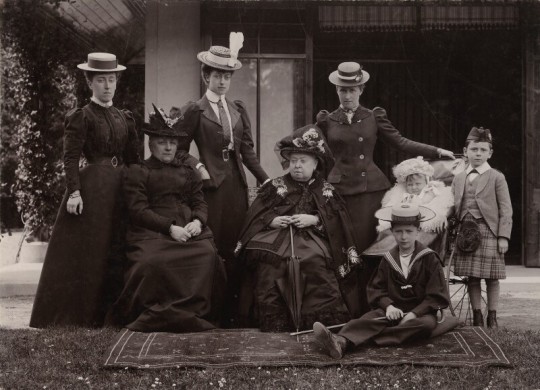
The Queen’s unknowing leave-taking of Scotland took place gradually, over these last days at Balmoral. Touchingly, she was still referring to ‘tea’ – although by now, it consisted only of arrowroot and milk – drinking it at her secluded Highland retreat of Alt-na-giubhsaich. Queen Victoria’s last day included luncheon in Prince Albert’s rooms with her youngest daughter, Princess Beatrice and her Battenberg children. She left Balmoral fittingly, with the weather ‘wretchedly gloomy & dark’ whilst with her, she had a wreath to take back to Windsor, to place on the tomb of the Prince Consort at Frogmore; possibly it also contained the Balmoral heather she loved so much. Perhaps there may have been a presentiment, within the sentimental.

The Queen’s trusted doctor, Sir James Reid was with her at Osborne when she died, so presumably, the Queen would have had the comfort of a Scottish voice at her side, in between her lingering states of consciousness.
After her death, the Prince of Wales spoke a moving sentence of gratitude for Reid’s devoted service: ‘You are an honest straightforward Scotchman… I shall never forget all you did for the Queen’ (read Christopher Hibbert, Queen Victoria: A Personal History, pg. 494).
Significantly, the Queen instructed amongst the many sentimental items to be put in her coffin ‘some of which none of her family were to see’, a photograph of her devoted Highland servant, John Brown, which she ordered to be placed in her left and, with a lock of his hair. These were both tactfully hidden inside a silken case, the handiwork of the Queen’s late wardrobe maid Annie MacDonald, wrapped in tissue paper.
Afterwards, the Queen’s left hand was covered with Queen Alexandra’s flowers. Also put into the Queen’s coffin was a simple sprig of Balmoral heather, which Sir James Reid covered with a quilted cushion – made especially to fit the coffin – to preserve the Queen’s privacy in death.

Scotland was at her funeral, in the form of her Highland ghillies, as the Queen’s German grandson, Ernst Ludwig, Grand Duke of Hesse, wrote in his private memoirs: ‘[The moment] when her coffin was lowered in the mausoleum at Frogmore, remains unforgettable to me… I remained a moment there alone. When I looked about me, there were kneeling near me all of her ghillies [Highland servants] from Scotland, all strong, sturdy men, who were weeping there uncontrollably like sons for their mother…’ For her funeral, the Funeral March by Handel was substituted as per the Queen’s instructions, for music by Chopin and Beethoven and importantly, Highland dirges.
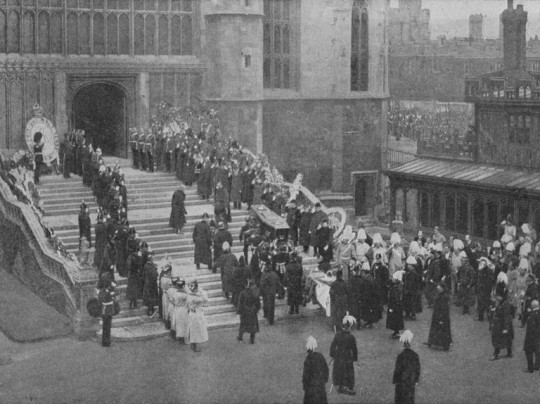
The sarcophagus or tomb chest was hewn from a flawless block of grey Aberdeen granite from the quarries at Cairngall in Scotland. Three attempts were made before this one was successfully carved out and it is purportedly the largest of its kind ever to have been hewn for such a use.

It was an appropriate Scotch bed for the Queen’s final sleep. Upon this sarcophagus, the effigies of Prince Albert and Queen Victoria lie still, a more sublime rendering of their marriage bed, staring into the beyond. Touchingly though, the head of Queen Victoria’s effigy is half-turned towards that of Prince Albert, as if it somehow suggesting that he died before she did. As in life, she is leaning, straining after the beloved husband that she mourned for half of her life.

The fact that their sarcophagus was quarried in Scotland is an appropriate choice for a royal couple who loved that country so much, becoming a little more Scotch with every visit. Appropriately for the Queen, parts of Eastern Central Scotland still celebrate Victoria Day, the last Monday before or on 24 May, Queen Victoria’s birthday.
Scotland was indeed with them, in the end. And continues to be with the House of Windsor.

#queen victoria#quote#monarchy#royalty#scotland#balmoral#queen#prince albert#highlands#tartan#victoria day#john brown#history#british#britain
67 notes
·
View notes
Photo
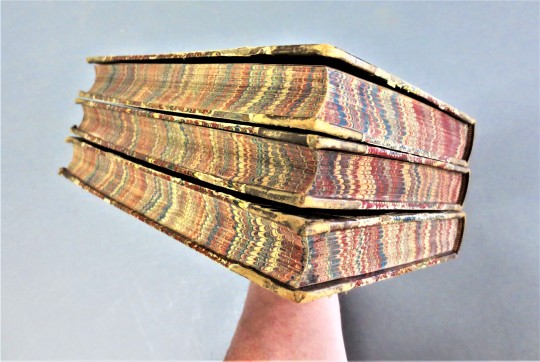

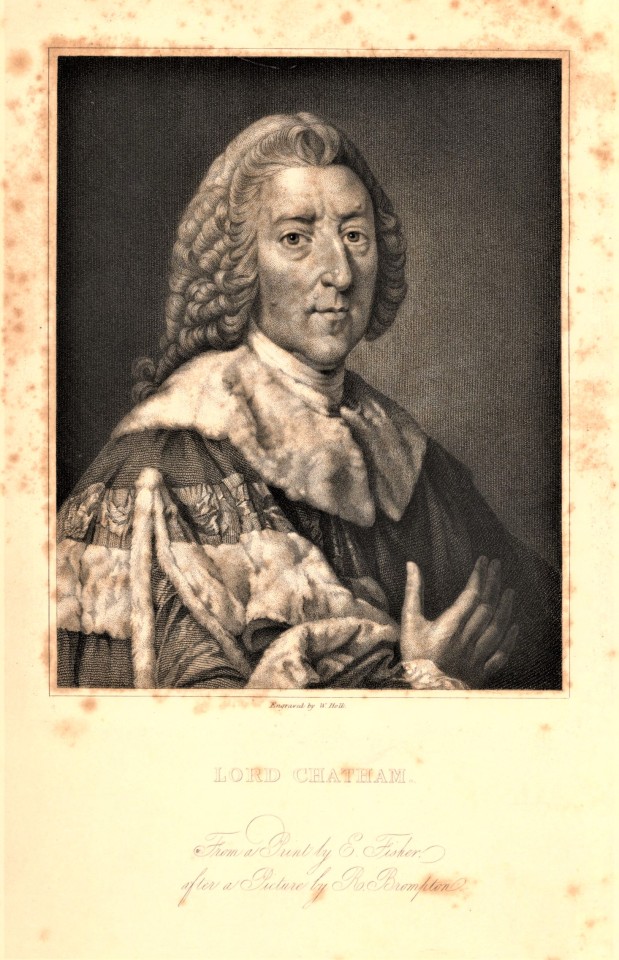







Fore Edge Friday
Here are some nonpareil bindings, edges, and endpapers for some nonpareil (e.g., unparalleled) Historical Sketches of Statesmen Who Flourished in the Time of George III by Henry, Lord Brougham, the second edition printed in three volumes in London by William Clowes and Sons for Charles Knight & Co., 1839-43. The volumes are half-bound in gold-stamped and blind-tooled calf skin with cover papers, edges, and endpapers marbled in what the University of Washington’s site on Patterned Papers identifies as a Nonpareil pattern. We have described the process for making this pattern in a previous post.
The author, Henry Peter Brougham, 1st Baron Brougham and Vaux (1777-1868), was a prolific writer on science, philosophy, and history, and published this set after his stint as Lord High Chancellor of Great Britain (1830-34). The volumes are dedicated to his wife Mary Anne Eden, 1st Baroness Brougham and Vaux (1785–1865).
The set is replete with with engravings of its subjects and each volume bears a frontispiece of a statesman. Shown here are the frontispiece portraits of William Pitt, 1st Earl of Chatham (volume 1) engraved by William Holl the Younger after an engraving by Edward Fisher from a painting by Richard Brompton, and George Washington (volume 2) engraved by William Humphrys after a painting by Gilbert Stuart. Despite the prominence of Washington’s portrait as the frontispiece to volume 2, Brougham only spends five pages on him. Nevertheless, he calls Washington “the greatest man of our own or of any age. . . . It will be the duty of the Historian and the Sage in all ages to let no occasion pass of commemorating this illustrious man; and until time shall be no more will a test of the progress which our race has made in wisdom and in virtue be derived from the veneration paid to the immortal name of Washington!”
View our other Fore Edge Friday posts.
#Fore Edge Friday#marbled papers#marbled edges#marbled book edges#Nonpareil marbling#Nonpareil pattern#marbling#paper marbling#Henry Peter Brougham#William Clowes and Sons#Charles Knight & Co.#Historical Sketches of Statesmen Who Flourished in the Time of George III#Mary Anne Eden#William Pitt#George Washington#William Holl#Edward Fisher#richard brompton#william humphrys#Gilbert Stuart#engravings#portraits#frontispiece portraits#engraved frontispiece
27 notes
·
View notes